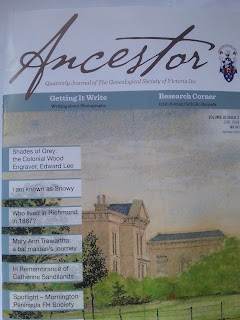When I say the name "JOHN ARMSTRONG" to you, what kind of image of the man does it conjure up? For me the name Armstrong is Scottish. Now add in that he was born in 1800, and died in 1850 in Adelaide, South Australia. You could surmise that he was a traveller, an adventurer, perhaps drawn to the gold rush in that area when the state was very young. His occupation was a stoker, perhaps on the very ship in which he travelled to Australia. We know that many crew members jumped ship at locations where gold was found. What is your picture of John Armstrong so far?
 |
| Adelaide ca. 1850. Drawing by Samuel Calvert. State Library of South Australia. |
Now add to your picture that he married a young Scottish widow with an infant daughter in 1842. How do you picture him now? Finally, add in your picture that he was buried in Adelaide by the government in 1850. We could surmise that he didn't "strike it rich" if his wife couldn't afford his burial. Now add in that he was a black African man. Wait, what?
Pre-conceptions. Mine. Armstrong = Scottish = white. I had lived with my preconceptions of a Scottish John Armstrong for a long time. As you research a person in your family tree, you can live with your own preconceived ideas for years sometimes. I got the shock of my life when I was proved so unutterably wrong. John Armstrong was a black African man, and our family had inherited his black skin.
Previous generations of our family had very dark skin, so we have always known that there was black ancestry somewhere back in the mists of time. We knew, for example, that John Armstrong's daughter Elizabeth had married an African man, (the elusive Sims Cummis that I have written about so many times on this blog). We have a photograph of one of Elizabeth and Sim’s children, who I discovered had the nickname “Snowy” because of his beautiful chocolatey dark skin. Their daughter was nicknamed "Blossom" for the same reason (she was my great great grandmother). We had all presumed our family’s dark skin came from their father, Sims. But we have no absolute proof that Sims was dark-skinned. All we know about Sims for sure is that he too was born in Africa. That fact by itself doesn’t prove that our family’s dark skin was inherited from him.
Fast forward now until I discovered a John Armstrong mentioned in an Adelaide newspaper dated 1841, describing John and his mate as "two African blacks". I was astonished. Could this be my John Armstrong? The chances of him being my John Armstrong were good, as the population of South Australia was exploding but still only about 10,000 at the time. John Armstrong is a common name though, and there was one other John Armstrong in Adelaide at the time. I discovered him again in another newspaper article, this time, described as "a man of colour". Further investigation proved that yes, this particular John Armstrong was indeed my 4x great grandfather. I had made a massive, incorrect, culturally stereotyped assumption about the name Armstrong.
Although I hate the racist description in the newspaper, I am in some ways grateful for it. It is a reflection of its own time. Without that description “two African blacks” I never would have gotten the whole clear picture of John Armstrong. Without it, I would never have understood the full implication of the harsh realities that John Armstrong encountered over his lifetime. And the newspaper descriptions are proof enough that our family’s dark skin was inherited from Snowy’s maternal grandfather, the black African John Armstrong. (Whether his father Sims had dark skin too is yet to be verified, although it does seem likely.)
But this whole incident taught me the hardest lesson any genealogist can learn.
Keep clear what are facts in your research and only work from there. Never make the arrogant mistake of assumption. Be on the lookout for your cultural stereotypes that are so insidious, you don’t even know that they exist. Our ancestors were individuals, and they made unique choices, so every research option must be explored in order to honour their individuality.
Next week, John Armstrong makes his choices in Adelaide in 1840.
Historically yours,
Valerius Copernicus
PS. Recent DNA evidence shows that our African roots stem from Mali, Benin/Togo, and Senegal.
Image from State Library of South Australia: B1134
http://www.catalog.slsa.sa.gov.au:80/record=b2064839~S1











